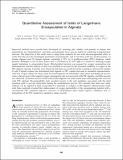Quantitative Assessment of Islets of Langerhans Encapsulated in Alginate
Author(s)
Johnson, Amy S.; O'Sullivan, Esther; D'Aoust, Laura N.; Omer, Abdulkadir; Bonner-Weir, Susan; Fisher, Robert J.; Weir, Gordon C.; Colton, Clark K.; ... Show more Show less
DownloadJohnson-2011-Quantitative Assessm.pdf (444.4Kb)
PUBLISHER_POLICY
Publisher Policy
Article is made available in accordance with the publisher's policy and may be subject to US copyright law. Please refer to the publisher's site for terms of use.
Terms of use
Metadata
Show full item recordAbstract
Improved methods have recently been developed for assessing islet viability and quantity in human islet
preparations for transplantation, and these measurements have proven useful for predicting transplantation
outcome. The objectives of this study were to adapt these methods for use with microencapsulated islets, to
verify that they provide meaningful quantitative measurements, and to test them with two model systems: (1)
barium alginate and (2) barium alginate containing a 70% (w/v) perfluorocarbon (PFC) emulsion, which
presents challenges to use of these assays and is of interest in its own right as a means for reducing oxygen
supply limitations to encapsulated tissue. Mitochondrial function was assessed by oxygen consumption rate
measurements, and the analysis of data was modified to account for the increased solubility of oxygen in the
PFC-alginate capsules. Capsules were dissolved and tissue recovered for nuclei counting to measure the number
of cells. Capsule volume was determined from alginate or PFC content and used to normalize measurements.
After low oxygen culture for 2 days, islets in normal alginate lost substantial viable tissue and displayed necrotic
cores, whereas most of the original oxygen consumption rate was recovered with PFC alginate, and little necrosis
was observed. All nuclei were recovered with normal alginate, but some nuclei from nonrespiring cells were lost
with PFC alginate. Biocompatibility tests revealed toxicity at the islet periphery associated with the lipid
emulsion used to provide surfactants during the emulsification process. We conclude that these new assay
methods can be applied to islets encapsulated in materials as complex as PFC-alginate. Measurements made
with these materials revealed that enhancement of oxygen permeability of the encapsulating material with a
concentrated PFC emulsion improves survival of encapsulated islets under hypoxic conditions, but reformulation
of the PFC emulsion is needed to reduce toxicity.
Date issued
2011-04Department
Massachusetts Institute of Technology. Department of Chemical EngineeringJournal
Tissue Engineering. Part C, Methods
Publisher
Mary Ann Liebert
Citation
Johnson, Amy S. et al. “Quantitative Assessment of Islets of Langerhans Encapsulated in Alginate.” Tissue Engineering Part C: Methods 17 (4) (2011): 435-449. Copyright © 2011, Mary Ann Liebert, Inc.
Version: Final published version
ISSN
1937-3392